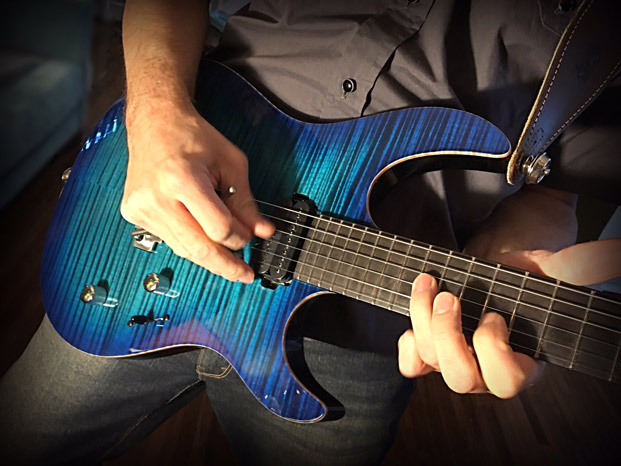How to Incorporate Suspended Chords into Heavy Metal Rhythm Guitar Parts
Learn a few different examples of rhythm-guitar ideas that jump around harmonically and also feature the incorporation of suspended chords.

One of the coolest things about contemporary metal is that its harmonic palette is wide open. It’s not uncommon for a great metal riff to jump back and forth from one type of harmonic environment to another, such as from the natural minor scale to the Phrygian mode to the Mixolydian mode to the blues scale.
Countless examples abound in the music of such great bands as Metallica, Megadeth, Pantera, At the Gates, In Flames and others. This month, I’d like to demonstrate a few different examples of rhythm-guitar ideas that jump around harmonically and also feature the incorporation of suspended chords, namely sus2 and sus4 chords.
With sus2 and sus4 chords, the third is replaced by the second or fourth, respectively, each substitution giving the chord a mysterious quality that is neither major nor minor.
FIGURES 1 and 2 are built from shifting two-note chord forms played against pedal tones. In FIGURE 1, I begin with a two-note root-fifth A5 power chord on the D and G strings and proceed to play descending two-note shapes against an open A-string pedal tone. After striking the A5 power chord in bar 1, the next two-note chord is A(b5).
Keeping the A root note in place, the E note on the G string shifts down one fret, to Eb, the flatted fifth. In bar 2, I move these shapes down a whole step, two frets, so now the first two-note chord is A7sus4 (or G5/A), followed by A7. In bars 3 and 4, I move the fretted shapes over to the A and D strings, and bar 4 includes three different two-note chord types: A5, Asus2 and Am7. Bars 1 and 2 then repeat, after which I wrap up the figure with B5 and C5 power chords. The last phrase (bar 8) is based on quick hammer-ons and pull-offs on the bottom two strings that move from the index finger and pinkie to the open string.
FIGURE 2 has us alternating between root-fifth chords and root-sixth and root-sharp-five chords. Once again, the lower note in each chord is used as a repeating pedal tone. In bar 4 of this example, I additionally include an index-finger barre across the A and D strings to sound F5/C, which can also be analyzed as Csus4. This rhythm part ends with a “Crazy Train”-type single-note line built from a steady ascension from the starting note in each subsequent bar.
FIGURE 3 is a single-note idea based on the D Mixolydian mode (D E F# G A B C), with reference made to Dsus4, via the consistent use of the G note, which is the fourth of D.
All the latest guitar news, interviews, lessons, reviews, deals and more, direct to your inbox!


![Guitarists of the Year 2025 [L-R]: Nuno Bettencourt, Noel Gallagher, Buddy Guy, Kiki Wong, Dany Villarreal](https://cdn.mos.cms.futurecdn.net/6hxRXsBDNCPfdLGgr893pU.jpg)